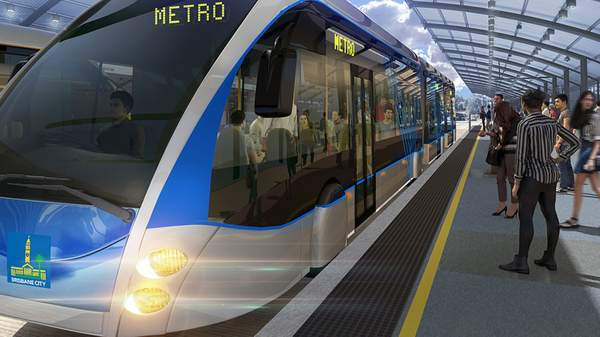Overview
Move over trains, buses and CityCats — Brisbane's getting a new form of public transport. Called the Brisbane Metro (and first announced back in 2016), it's set to shake up the city's transportation network, particularly around the CBD. And while there's been plenty of chatter about this 21-kilometre system over the past two years — expanding from one line to two, floating the idea of adding new stops and picking up top-level support just last month — Brisbane City Council have finally revealed the draft plans.
First, here's what we already knew: Brisbane Metro will span 18 stops along existing busway network, connecting Eight Mile Plains to Roma Street and St Lucia to Herston, with interchanges available at 11 stations. It'll use a new fleet of 60 vehicles, and each will be able to carry up to 150 people. As far as actually getting the system up and running, a new underground station be built at the Cultural Centre, as well as an underground tunnel beneath Adelaide Street across the river. Construction isn't slated until 2019 to 2022, with services commencing in 2023.
The new Brisbane Metro draft design report expands upon this basic outline — and it's safe to say that the city is in for quite the change. Most importantly, the plan delivers on the high-frequency aspect, with services set to run every three minutes in peak periods, every five minutes during the day between peak periods and every ten minutes at a minimum. That's quite an upgrade from existing bus services, and the Metro's overall operating hours improve things even further. Not only will it function from 5am until midnight from Monday to Thursday, but it'll operate constantly from 5am Friday until midnight Sunday. Yep, it won't stop all weekend.
To implement all of the above, closing the Victoria Bridge to traffic had already been floated, and this is definitely part of the plan. It'll become a green bridge for Metro and bus services only, plus pedestrians and cyclists. North Quay will also close to traffic from William Street to Ann Street, which is going to make getting around the CBD by car rather tricky. Of course, the area is already undergoing a huge revamp anyway as part of the Queen's Wharf development.
A heap of other road changes will come into effect around the Cultural Centre, too, while new above-ground bus stops will pop up on Melbourne Street in South Brisbane. Along the busway, all existing stations along will require upgrades, and a new depot will be built at Rochedale. A few current buses routes will also be discontinued, such as the 111, 160 and 66. All other high-frequency busway services, such as the BUZ, CityGlider and peak Rockets, will continue to run.
In total, Brisbane Metro aims to improve travel times by 30 percent in morning peak periods and 50 percent in the afternoon — which, if it really does pan out, is something every Brisbanite would welcome. The system will carry an extra 22,000 passengers per hour compared to today's network, and it's forecast that 125 buses won't need to travel on the CBD's streets as a result.
The draft design report is currently open for public comment until May 25, with information sessions taking place in the inner-city, Woolloongabba, Holland Park, Herston, Upper Mt Gravatt and South Brisbane between April 28 and May 18. From here, the council will draw up detailed specifications to gain final approval and funding.
